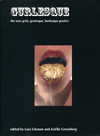Gurlesque
The highly-anticipated poetry anthology, Gurlesque: The New Grrly, Grotesque, Burlesque Poetics has aroused a vigorous discussion since its release. Most of the discussion has surrounded the concept, definition, and limitations of “Gurlesque,” a term coined by co-editor Arielle Greenberg in 2002 to map certain tendencies of a number of female American poets born between the late sixties and the early eighties writing in this last decade.
The highly-anticipated poetry anthology, Gurlesque: The New Grrly, Grotesque, Burlesque Poetics has aroused a vigorous discussion since its release. Most of the discussion has surrounded the concept, definition, and limitations of “Gurlesque,” a term coined by co-editor Arielle Greenberg in 2002 to map certain tendencies of a number of female American poets born between the late sixties and the early eighties writing in this last decade.
The appeal of the term is the visceral way it captures the funny, sexy, gross, irreverent, experimental, and the idea of hybrid – all critical parts of the poetry in the anthology. Couple this with the critical theory underpinning that has been developed by co-editor Lara Glenum (among others), and you suddenly have something that looks like a burgeoning contemporary American poetry movement (though both Greenberg and Glenum deemphasize this in their respective introductions).
While a lot of interesting and productive discussion about Gurlesque has emerged in the wake of the anthology’s release, as is often the case when discussing such a striking artistic concept, discussion can veer from the most important part – the work itself; in this case, the poems of this anthology. Much of the discussion about Gurlesque would never have been written if the book were called 18 Younger Female Poets, or some such. Bland as that title might be, it would not detract from the poetry included, and furthermore, would not mitigate the exciting ways in which each poet’s work vibes against and compliments other poetry in the anthology.
The poets in Gurlesque – Ariana Reines, Brenda Coultas, Brenda Shaughnessy, Catherine Wagner, Cathy Park Hong, Chelsey Minnis, Danielle Pafunda, Dorothea Lasky, Elizabeth Treadwell, Geraldine Kim, Heidi Lynn Staples, Kim Rosenfield, Matthea Harvey, Nada Gordon, Sandra Lim, Sarah Vap, Stacy Doris, Tina Brown Celona (along with a color insert of visual artists with similar impulses) – are writing some of the best contemporary American poetry right now and deserve a wider audience.
The number of poets in the anthology could likely have doubled, but the editors, where they could have gone the way of many anthologies and given sixty different poets a page or three, have wisely decided to offer deep cuts of each poet’s work (ranging generally from eight to fifteen pages of poetry). While one of the connecting themes of the poets in the anthology is the “queering” of female identity and sexual desire (for males, not homosexual desire, as poet and critic Amy King rightly points out), it is critical to stress the variety of ways that each poet does this.
Ariana Reines, for example, has poems that are as violent and scatological as they are formally disparate, elliptical, and linguistically playful: “Liquid shoot into her skull and leak out her eyehole.” Since it is “shoot” not “shoots,” “leak” not “leaks,” the effect, as in much of the poems from Reines, is of an off-kilter volatility that is strange, dangerous, and compelling. All the more volatile when she is straightforward: “If I don’t fuck today I’ll die.”
Catherine Wagner shares a similar strategy, with brutal, bleakly funny poems of female debasement (“Shoulderblades frayed the cloth I’m made of / Sewn up my neck round speaking hole / and ragged with snot”) that curdles into mockery of male power and insecurity: “Am not required to praise, required to love I am / Praise for him falls short of what himself can give,” and
Now let us have ceremonial
sex.
Who is the pauper?
I will be. I will be.
Poets like Brenda Shaughnessy work in a different, but no less arresting register. Shaughnessy utilizes traditional formats like quatrains and couplets, and offers more traditionally lyrical reflections, as in “Your One Good Dress” where the poet writes how a dress wraps around identity and duty, “This black dress is your one good dress. / Bury your children in it. Visit your pokey / home town friends in it. Go missing for days.” Or in “Parthenogenesis” a meditation on being overweight or losing weight. Where another poet in this anthology may have used the space to scorn societal norms, Shaughnessy is more personal: “For me, starving, that coreless, useful feeling, / is not making myself smaller / but making myself bigger, inside. / It’s prince and pauper both, it’s starving artist / and good model in one masterpiece.” The effect is broadly romantic, yearning.
These poets have been brought together because they share similar impulses, but it would be an error to see these poems as programmatically fulfilling the criteria set out by the editors in the anthology. The editors rightly are forthcoming with caveats that not all poets here maybe consider themselves Gurlesque. In fact, what is most exciting about Gurlesque is how these similar emotional and intellectual drives have been refracted in such new and strange ways by each of these young poets.





